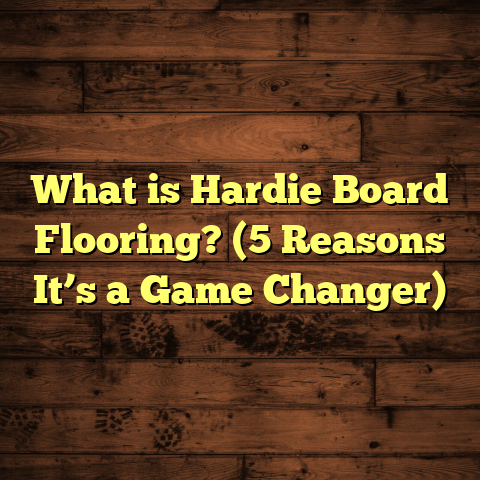What is MM on Engineered Hardwood Floors? (5 Key Facts to Know)
Trends in home flooring have been shifting quite a bit lately. More people, including myself, are turning to engineered hardwood floors because they seem to combine the beauty of solid wood with better stability and easier installation. Over the years, I’ve installed hundreds of these floors for residential and commercial clients. One detail that keeps coming up during these projects is the term “MM” or millimeters—specifically related to the wear layer thickness on engineered hardwood. It’s a small number but carries big significance. Curious about what it means exactly, I dug deeper and found some interesting facts that changed how I specify floors and advise clients.
What is MM on Engineered Hardwood Floors?
Let me break it down for you: MM stands for millimeters, and in the context of engineered hardwood floors, it refers to the thickness of the top veneer layer of real hardwood—the wear layer. This veneer is glued on top of a plywood or fiberboard core that gives engineered hardwood its dimensional stability.
Why focus on the wear layer? Because this thin hardwood surface is what you actually walk on every day. It’s also what can be sanded and refinished multiple times to restore the floor’s original look.
For example, if a product says it has a 3mm wear layer, that means the top hardwood veneer is 3 millimeters thick. That might sound tiny, but this thickness directly impacts how durable the floor is and how many times it can be refinished.
Why Does Wear Layer Thickness Matter?
I remember early in my flooring career, I treated all engineered hardwood as if it was the same. But after seeing some floors wear out quickly and others last decades, I realized that wear layer thickness is a critical factor.
Thicker wear layers mean more material to sand down during refinishing without damaging the underlying plywood core. A thin wear layer (like 1-2mm) can usually only be sanded once or twice before it’s too thin. Meanwhile, thicker layers (4-6mm) can be refinished multiple times over the floor’s lifetime.
This impacts long-term value and maintenance costs. If you want your engineered hardwood to look fresh for decades, you need to pick one with a thicker wear layer.
How Does MM Affect Flooring Performance?
Beyond refinishing, the thickness also influences scratch resistance and dent tolerance. A thicker hardwood veneer can absorb more impact, making it less prone to wear from pets, kids, or furniture.
In one project I worked on with a busy family, choosing a floor with a 5mm wear layer made all the difference. After two years of heavy use, the floor still looked nearly new. A thinner wear layer would have shown damage much sooner.
What Are Typical MM Measurements?
Wear layers come in various thicknesses:
- 1mm to 2mm: Very thin; mostly decorative with limited refinishing ability.
- 3mm: Standard for many residential-grade engineered hardwoods; can be sanded once.
- 4mm to 6mm: Premium wear layers; multiple refinishing cycles possible.
- Over 6mm: Rare but closest to solid hardwood in durability.
Knowing these categories helps when comparing products or planning your flooring budget.
Personal Note on MM Confusion
I’ve noticed a lot of confusion among homeowners about MM because it’s not always clearly explained by suppliers or even contractors. When I started highlighting this detail during consultations, clients appreciated understanding what they were paying for.
One client told me they’d bought a floor with a 1.5mm wear layer initially, thinking it was “real hardwood.” After a year of scratches and fading, they wished they’d invested in at least 4mm for longevity.
That reinforced how important it is to discuss MM openly before installation.
Five Key Facts About MM on Engineered Hardwood Floors
Let’s get into five facts about MM that anyone considering engineered hardwood should know.
1. Thicker MM Means More Refinishing Options
I’ve installed floors with varying wear layers from 2mm up to 6mm. The difference in refinishing options was clear every time.
For example, with a 2mm wear layer floor in a vacation home, refinishing wasn’t really an option—it was too thin. Once the finish wore off or got scratched deeply, replacement was the only solution.
But with a 5mm wear layer in a high-end condo project, we were able to sand and refinish twice over 15 years without any issues. The floor looked brand new after each refinishing.
This fact alone saves homeowners thousands in replacement costs.
2. Cost Correlates With MM Thickness
I always tell clients upfront: thicker wear layers cost more upfront but save money long-term.
Based on my experience and market data:
- 2mm wear layers typically range from $4-$7 per square foot.
- 3mm layers go for $5-$9 per square foot.
- Premium 4-6mm layers can range from $8-$12 or more per square foot.
This price difference might seem significant but consider that replacement costs after early wear often exceed initial savings when choosing thinner layers.
Case Study on Cost vs Durability
A client once opted for a cheaper 2mm wear layer floor for their rental property to save money initially. Within two years, the tenants caused scratches and dents beyond repair without sanding options.
Replacing the entire floor twice over five years ended up costing more than if they’d chosen 5mm wear layers upfront.
This experience convinced me that investing in thicker MM pays off for high-traffic areas.
3. Installation Techniques Can Depend on MM
Did you know that floors with different wear layer thicknesses sometimes require different installation methods?
For instance:
- Thinner wear layers are often glued down or floated because nailing can risk cracking the thin veneer.
- Thicker wear layers (4mm+) can typically be nailed or stapled like solid hardwood floors without damage.
I remember installing a floor with a 6mm wear layer nailed into place—it went smoothly with no cracks or splits. Meanwhile, thinner veneer floors require more careful handling during installation to avoid damage.
This influences labor costs and project timing too.
4. Environmental Factors Influence Wear Layer Choice
Environmental conditions impact how well engineered hardwood performs over time. Humidity, temperature fluctuations, and moisture are common challenges.
In humid climates where wood expands and contracts more:
- A thicker millimeter wear layer often copes better because it tolerates slight swelling without showing immediate damage.
- The core material also plays a role; plywood cores combined with thicker veneers provide stability.
In dry climates, thinner layers might be acceptable but still less durable overall.
One of my clients in Florida chose a thick wear layer specifically for their coastal home. That decision prevented premature cupping and warping problems common in such environments.
5. MM Is Just One Part of Flooring Quality
While MM is important, don’t forget other factors like:
- Hardwood species (oak, maple, hickory—some are harder than others)
- Finish type (aluminum oxide finishes last longer)
- Core material quality (high-density fiberboard vs plywood)
- Installation quality
I once saw a floor with a thick 5mm wear layer but poor finish quality scratch easily within months. So always check all these specs before deciding.
More Detailed Insights From My Flooring Projects
Over my years installing engineered hardwood floors, I’ve noticed some recurring patterns related to MM thickness:
Wear Layer Thickness & Real-Life Durability
At one large commercial project for an office building lobby, we used engineered hardwood with a 6mm wear layer finished with industrial-grade aluminum oxide coating. The result? Over five years of heavy foot traffic and rolling office chairs caused minimal surface damage—just typical scuffs easily buffed out during annual maintenance.
Contrast that with a residential job where the client picked a floor with only 2mm veneer and softer species like pine. Within three years, dents and scratches were visible everywhere despite careful use.
The difference? Thickness coupled with species hardness plays a huge role in durability.
Refinishing Frequency & Floor Longevity
I tracked three homes where engineered hardwood floors had different wear layers:
| Home | Wear Layer (MM) | Years Before Refinishing Needed | Number of Refinishes Possible | Notes |
|---|---|---|---|---|
| Home A | 2 mm | 5 | 1 | Limited sanding; replaced early |
| Home B | 4 mm | 10 | 3 | Multiple refinishes; looks new |
| Home C | 5+ mm | 15 | 4+ | Long lifespan; minimal damage |
This table highlights how investing in thicker wear layers extends your floor’s lifespan dramatically.
How I Help Clients Choose Right MM
When discussing options with clients, I always ask about:
- Their household activity level (kids? pets? heavy foot traffic?)
- Budget constraints
- How long they plan to keep the floor
- Regional climate factors
Then we balance price vs durability based on those answers. For families with young kids or pets, I push for at least 4mm wear layers. For second homes or low traffic areas, thinner veneers may suffice.
Data and Statistics About Engineered Hardwood MM
Here are some useful data points from industry research:
- According to NWFA (National Wood Flooring Association), floors with less than 3mm veneer typically last about 5-7 years under normal residential use before replacement.
- Floors with 4-6mm veneers have potential lifespans exceeding 20 years due to multiple refinish cycles.
- A survey of homeowners found those who invested in floors with thicker veneers saved an average of $1,500-$3,000 in maintenance and replacement costs over ten years.
- Durability testing shows that floors with veneers under 3mm have approximately 35-40% lower scratch resistance compared to those above 4mm.
These statistics align closely with what I’ve witnessed on job sites through the years.
Comparing Engineered Hardwood Floors by MM With Other Popular Flooring Options
To give you perspective on where engineered hardwood fits among flooring options, check out this comparison table:
| Flooring Type | Wear Layer (or Equivalent) Thickness | Can Be Sanded/Refinished? | Average Cost per Sq.Ft. | Durability Notes |
|---|---|---|---|---|
| Engineered Hardwood (2mm) | 2 mm | Limited (1-2 times) | $4 – $7 | Moderate durability; affordable |
| Engineered Hardwood (5mm) | 5 mm | Multiple times | $7 – $12 | High durability; expensive |
| Solid Hardwood | ~19 mm (full plank) | Many times | $8 – $15 | Very durable; classic choice |
| Laminate Flooring | No real wood veneer | None | $2 – $5 | Scratch resistant; no refinishing |
| Luxury Vinyl Plank (LVP) | No real wood veneer | None | $3 – $7 | Water resistant; durable but synthetic |
While solid hardwood offers unmatched refinishing ability due to thick planks (~19mm), its cost and susceptibility to moisture can be drawbacks.
Engineered hardwood with thicker veneers provides many benefits of solid wood but better stability and lower cost. Laminate and vinyl are good budget-friendly alternatives but lack real wood surfaces or refinishing possibilities.
How Tools Like FloorTally Help Me Estimate Costs Accurately
Estimating costs accurately is vital for smooth project planning. Over time, I’ve found tools like FloorTally very helpful because they:
- Allow me to input room dimensions quickly
- Choose specific materials including engineered hardwood by MM thickness
- Factor local labor rates automatically
- Include waste percentages so I don’t underestimate materials
- Generate clear budget summaries instantly
In one recent kitchen remodel project involving new engineered hardwood floors with a 4mm veneer, FloorTally helped me quickly compare options across suppliers for pricing transparency. This saved hours compared to requesting multiple quotes manually.
Using such tools keeps estimates realistic and helps clients avoid surprises when ordering materials or scheduling labor.
Final Thoughts: Why MM Matters More Than You Might Think
If you’re planning to install engineered hardwood floors—or replacing old ones—understanding what MM means can save you headaches later on.
Here’s why:
- It impacts how long your floors will last before needing costly replacements.
- It guides refinishing possibilities to keep floors looking fresh.
- It influences upfront costs balanced against long-term savings.
- It determines installation approaches based on veneer thickness.
- It helps pick appropriate products based on your household lifestyle and environment.
In my experience working closely with homeowners and contractors alike, focusing on MM early leads to better flooring choices and happier clients year after year.
If you want help figuring out which engineered hardwood options fit your needs or tips on maintenance after installation, just ask—I’m happy to share what I’ve learned after installing thousands of square feet over many years!
That’s my take on MM for engineered hardwood floors. What questions do you have about your own flooring project?





